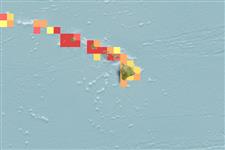>
Clupeiformes (Herrings) >
Engraulidae (Anchovies) > Engraulinae
Etymology: Encrasicholina: Greek, egkrasicholos, -os, -on = mixed with spleen.
More on author: Fowler.
Environment: milieu / climate zone / depth range / distribution range
Ecologia
marino; salmastro; distribuzione batimetrica 0 - 50 m (Ref. 189). Tropical; 25°N - 14°N, 165°W - 143°W (Ref. 189)
Eastern Central Pacific: endemic to Hawaii, but its use as a baitfish may spread its range.
Size / Peso / Age
Maturity: Lm ? range ? - ? cm
Max length : 7.5 cm SL maschio/sesso non determinato; (Ref. 189)
Spine dorsali (totale) : 0; Spine anali: 0; Raggi anali molli: 13 - 15. Most specimens without pre-pelvic scutes, but some with 1 to 5 thin needle-like scutes. Maxilla tip blunt, reaching to front border of pre-operculum, but scarcely projecting beyond second supra-maxilla. Isthmus short, preceded by a small fleshy plate on urohyal between branchial membranes. Anal fin short, its origin behind base of last dorsal fin ray.
Epipelagic (Ref. 58302). A schooling species living close inshore and entering bays, inlets, estuaries, canals and even penetrating into fish ponds, thus able to tolerate a wide range of salinities. Feeds mainly on planktonic crustacean larvae. Breeds throughout the year, with a peak in summer, spawning at night (between 2200 and 0200 hours) in bays and estuaries (Ref. 189).
Life cycle and mating behavior
Maturities | Riproduzione | Spawnings | Egg(s) | Fecundities | Larve
Spawn in bays and estuaries in school (Ref. 205). Spawning is said to be continuous throughout the season (Ref. 32412, 40290).
Whitehead, P.J.P., G.J. Nelson and T. Wongratana, 1988. FAO Species Catalogue. Vol. 7. Clupeoid fishes of the world (Suborder Clupeoidei). An annotated and illustrated catalogue of the herrings, sardines, pilchards, sprats, shads, anchovies and wolf-herrings. FAO Fish. Synop. 125(7/2):305-579. Rome: FAO. (Ref. 189)
IUCN Red List Status (Ref. 130435)
Threat to humans
Harmless
Human uses
Pesca: scarso interesse commerciale; esca: usually
Strumenti
Special reports
Download XML
Fonti Internet
Estimates based on models
Preferred temperature (Ref.
123201): 25 - 25.6, mean 25.3 °C (based on 32 cells).
Phylogenetic diversity index (Ref.
82804): PD
50 = 0.5039 [Uniqueness, from 0.5 = low to 2.0 = high].
Bayesian length-weight: a=0.00977 (0.00544 - 0.01757), b=3.20 (3.04 - 3.36), in cm total length, based on LWR estimates for this species & (Sub)family-body (Ref.
93245).
Trophic level (Ref.
69278): 3.1 ±0.30 se; based on food items.
Resilienza (Ref.
120179): Alto, tempo minimo di raddoppiamento della popolazione meno di 15 mesi (K=1.7).
Fishing Vulnerability (Ref.
59153): Low vulnerability (10 of 100).
